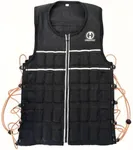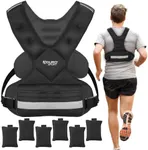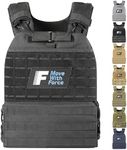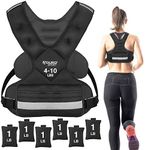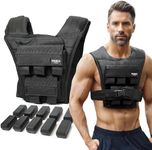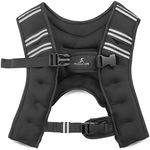Buying Guide for the Best Weighted Vests
Choosing the right weighted vest can significantly enhance your workout routine, whether you're into running, strength training, or bodyweight exercises. The key is to find a vest that fits well, is comfortable, and meets your specific fitness goals. Here are some important specifications to consider when selecting a weighted vest.Weight CapacityWeight capacity refers to the maximum amount of weight the vest can hold. This is important because it determines how much resistance you can add to your workouts. Vests typically range from 10 to 50 pounds. For beginners or those focusing on endurance, a lower weight capacity (10-20 pounds) is ideal. Intermediate users might prefer 20-40 pounds, while advanced users or those focusing on strength training might opt for 40-50 pounds or more. Choose a weight capacity that aligns with your fitness level and goals.
AdjustabilityAdjustability refers to how easily you can change the weight of the vest. This is crucial for tailoring the resistance to different exercises or as you progress in your training. Some vests have fixed weights, while others allow you to add or remove weight packets. If you want versatility and the ability to gradually increase resistance, look for a vest with adjustable weights. Fixed-weight vests are simpler and might be suitable if you have a specific weight in mind for your workouts.
Fit and ComfortFit and comfort are about how the vest feels when you wear it. A well-fitted vest should be snug but not restrictive, allowing for a full range of motion. Look for features like adjustable straps, padded shoulders, and breathable materials. If you plan to wear the vest for long periods or during high-intensity workouts, comfort becomes even more critical. Try on different vests if possible to find one that fits your body shape and feels comfortable during movement.
Material and DurabilityThe material and durability of the vest determine how long it will last and how well it will withstand intense workouts. Common materials include neoprene, nylon, and mesh. Neoprene is durable and provides good padding, nylon is lightweight and strong, and mesh offers breathability. Consider the type of workouts you'll be doing and choose a material that can handle the wear and tear. Durability is especially important if you plan to use the vest frequently or for high-impact activities.
Design and MobilityDesign and mobility refer to how the vest is structured and how it affects your movement. Some vests are bulkier, which might restrict certain exercises, while others are streamlined for better mobility. If your workouts involve a lot of running, jumping, or dynamic movements, look for a vest with a sleek design that allows for maximum mobility. For strength training or less dynamic exercises, a bulkier vest might be acceptable.
Ease of CleaningEase of cleaning is about how simple it is to keep the vest hygienic. Since you'll be sweating in it, a vest that is easy to clean is important for maintaining hygiene and longevity. Some vests have removable weights and are machine washable, while others require hand washing. Consider how much effort you're willing to put into cleaning and choose a vest that fits your maintenance preferences.

